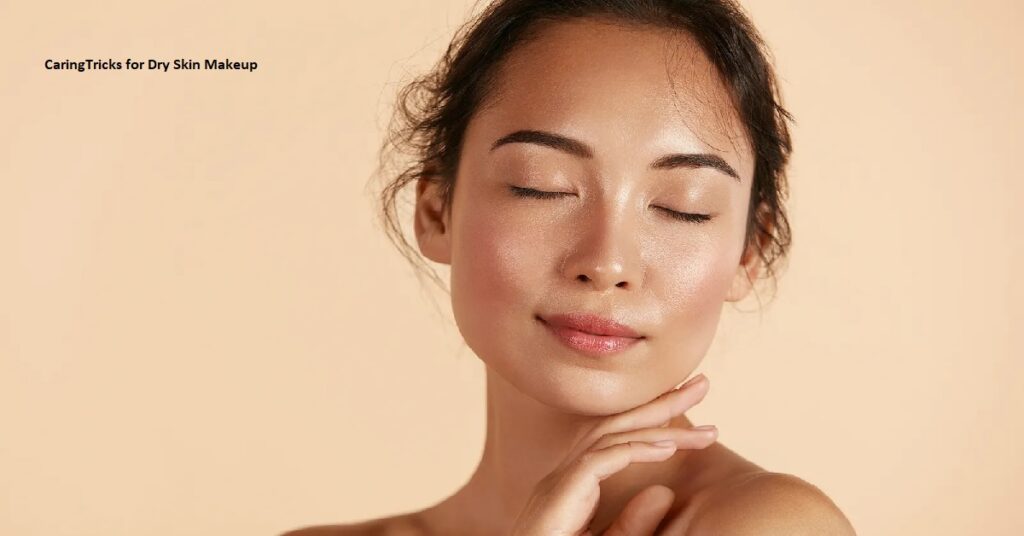How to do Makeup for Dry Skin in Winter?

Generally speaking, winters are rough on the skin because of the chilly temperatures, low humidity, and brisk winds. Your skin may lose all of its moisture as a result, becoming drier and flakier. It goes without saying that putting makeup to skin with this sort of texture may be extremely difficult because it tends to highlight dry, uneven areas instead of blending in with them.
Winter is a time for celebrations, and you eagerly anticipate trying out new beauty looks each day. However, this time of year is also when it can be challenging to achieve a smooth base and a dewy makeup look. Your appearance might be utterly ruined if the foundation sticks to the dry areas of your face. Do not fret, though; this catastrophe may be averted with the use of the proper advice and methods. You can perform the following.
Please consider listening to us before you lose hope and decide not to use cosmetics throughout the winter. By adhering to the winter cosmetic guidelines listed below, you may simply avoid the issue and make your dry skin makeup-friendly. Investigate them. For dry skin makeup, there are 13 guidelines that must be followed.
1)Wash Your Face Before Applying Makeup:
This is a rule that applies to all skin types. As a result, your skin will be smooth and ready to accept any cosmetics, providing you with the perfect canvas for your makeup. It will help remove any makeup or other cosmetics you might have used that are still on your face. This will stop pore clogging and outbreaks. Cleanser your face gently with a face wash made for dry skin. Face cleansers designed for regular or oily skin are excessively harsh and could exacerbate dryness.
2)Always Apply Moisturizer First:
Moisturizing should be a regular component of your skin care regimen, but it’s crucial while wearing makeup. It aids in laying down a moisturized, silky foundation for makeup application.
Applying a healthy moisturizer prior to applying your makeup is essential for giving your foundation a flawless, skin-like finish. But rather just putting it on whenever, we advise applying it to moist skin and massaging the cream into your skin for a few minutes. The region from around the nose and the area between the brows is frequently dry. Use a moisturizer that is highly moisturizing and designed for dry skin. Apply just enough moisturizer to the skin so that it absorbs it, but not too much that it makes the skin feel oily.
Use the Proper Moisturizer:
To combat dryness in winter, a heavy moisturizer may not be the best option. You must choose a formula that is appropriate for your skin type. Choose a gel-based moisturizer with nourishing elements if you have oily skin.
3) Apply Primer:
The holy grail of cosmetics is primer. It not only extends the wear of your makeup but also produces a smooth surface for it to slide over. Before applying makeup, prime the face with a little layer of primer so that dry spots of skin won’t be covered in makeup. To give your face a wonderful dewy look that will stay all day, use a hydrating primer rather than a mattifying one.
Apply primer by placing a small amount on your finger and patting it into different areas of the face.
Apply the primer sparingly. Choose a gel-based moisturizer with soothing elements if you have oily skin. Use two dots for bigger regions like your cheeks or forehead, and one dot for small parts like your chin and nose.
Select A Moisturizing Primer:
Even though a primer is very necessary, choosing the wrong kind will have little to no effect on the way your makeup looks. Vitamin E, which nourishes the skin and provides the smoothest basis for your foundation to slide on, should be included in your primer.
4) Avoid Anything that is Excessively Powdered:
Powder can diminish the appearance of fair skin. It is recommended to put all of your powder-based cosmetic items in the back of the drawers, at least throughout the winter, if you have dry skin. Powder-based makeup might seem dreary and lifeless because it absorbs the skin’s natural oils and is too drying. So instead of using them in the winter, switch to cream or liquid treatments, which are far more moisturizing and won’t stick to your face’s dry regions.
5) Select Your Base Formula Wisely:
When applying foundation to dry skin, use moisturizing, illuminating liquid formulations. Foundations that are too matte might accentuate dryness and make it worse. When your skin is already dry, powder cosmetics can settle on it and make it appear much drier.
If you choose a liquid foundation, which offers a breathable, natural finish, you may build up the coverage as much as you like without it seeming cakey.
A lighter product, such as a tinted moisturizer, BB cream, or CC cream, can cover any dry patches better than a full-coverage foundation. This can avoid a cakey look and cosmetics adhering to dry flakes.
Place Foundation on:
Choose a region of your face and begin applying foundation there. Apply liquid foundation to your face by dabbing a little quantity of it onto your finger and tapping it there. To make the foundation mix into your skin, use a foundation brush. Your whole face, excluding the region around your eyes and your eyelids, should be repeated as desired.
You could find that your skin is frequently flaky if you suffer from dry skin. Since brushes are softer than fingers, using a brush to mix makeup reduces flaking.
With the brush, don’t apply too much pressure. Instead, apply the foundation to the region you are working on with a gentle sequence of repeated taps that blend in.
Don’t Rub, Pat:
While moist beauty sponges work best for applying foundation when you have dry skin, brushes are wonderful for applying focused cosmetics like blush and eyeshadow. The wet sponge offers a little more moisture to your skin, preventing wrinkles from forming and dry spots from sticking to the makeup.
Make careful to apply foundation in a single path using a brush or pressing motion with a makeup sponge when doing so on dry or peeling skin. To avoid causing friction to the skin and further skin peeling, avoid vigorously rubbing the brush over the face in various directions.
6) Put on Concealer:
After properly preparing the skin with skincare, you may hide dry areas with a moisturizing concealer. Don’t massage the concealer on; rather, spot treat. This leads us to our next point.
On your under eye region and any other region you feel requires additional coverage, use a watery or cream concealer. Apply concealer in a series of tiny pats, just as you would liquid foundation. Use a little brush that can go beneath the eyes all around.
7) When Using Powders, Think Strategically:
Contrary to common opinion, if you have dry skin, you do not have to avoid powder formulations entirely. Whether you have matte or mixed complexion, you may use powder, but you must be careful where you apply it.
Use the powder sparingly, just where extra setting or coverage is required. Additionally, choosing a powder with finely milled particles and one that isn’t full coverage, since the latter might give the appearance of dry skin.
Instead of setting your makeup with powder, you may use setting spray. Holding the spray approximately a foot away from your face, lightly spritz your face. Instead of absorbing valuable moisture like setting powder will, setting spray offers a hydrating effect.
8) Use Liquid or Cream Blush:
Again, powders could accentuate dry skin’s appearance, so use cream or liquid blush and bronzer formulations instead. The consistency of cream blush is light and airy, blending easily onto the skin and leaving a dewy shine behind.
Try a liquid blush if your cheekbones and cheekbone regions are prone to drying, which causes your blush to apply unevenly. In addition to applying more smoothly, liquid blush also withstands heat better and lasts longer. Apply a tiny amount of liquid blush using a blush brush in small portions on your cheekbones.
9) Cream Contour:
Don’t forget to use a cream contour to carve out your cheekbones! In a pinch, you may also apply bronzer or a concealer that is 1 to 2 shades darker than your skin tone. All are really effective at sculpting your face and enhancing your complexion without seeming cakey.
10) Glow with Highlighter:
Sadly, dry skin might occasionally appear dull, but fortunately, you can apply an illuminator to help revive the appearance of your glow. Use a liquid highlighter to create the appearance of brilliance over your cheekbones.
Use highlighter to get a dewy appearance. Use a liquid highlighter to give your complexion a fresh, dewy look if you are worried that it looks dry. Put a drop of liquid highlighter on the top of each cheekbone. Along the ridges of your cheekbone, pat it in with your finger in a diagonal motion. While using highlighter will give you a youthful and healthy appearance, it won’t truly make the skin less dry.
11) Cream Eyeshadow:
Cream eyeshadows with a shimmer are not only attractive, but also ideal for people with dry skin. You won’t ever have to worry with bothersome fallout thanks to the lightweight, non-greasy texture of the very glittery eyeshadow, which lasts all day.
Apply the product to your lids using the doe-foot applicator, then mix with your finger or a brush. It is that simple.
Utilize Eye Makeup:
Apply your eyeshadow as you normally would after priming your eyes. With the primer on, you should see that it is simpler to mix your eyeshadow and that your liner pencil applies more easily. Instead of using pencil eyeliner if you discover that your eyelids are still dry, use liquid eyeliner. Although they are more difficult to mix than powder eyeshadows, cream-based eyeshadows are also an option.
12) Option for a Hydrating Lipstick:
Your lips may also feel and appear dry, in addition to your face. Drying lipsticks should be avoided since they will merely highlight texture and exacerbate dryness and discomfort.
Put on Some Lipstick:
Your lips could feel dry by the time you have applied your foundation, blush, and eye makeup. Put on a little layer of ChapStick. Apply your lipstick after giving it a minute to seep in. Long-lasting or matte lipsticks should be avoided as they have a drying effect.
If you do choose to apply a matte lipstick and it leaves your lips feeling dry, pat your lips with a touch of Vaseline or ChapStick that you’ve applied on your finger. Your lips will feel hydrated after doing this, which will offset the drying impact of the lip cream you’re applying.
13) Use A Face Mist to Revitalize Your Skin:
Since it’s winter, it’s possible that a few hours after wearing makeup, your skin may start to feel a touch tight and dry. Even while this is quite natural, it may nevertheless be very unpleasant. But simply using some facial mist every couple of hours, you may easily get over this pain.
If you do choose to apply a matte lipstick and it leaves your lips feeling dry, pat your lips with a touch of Vaseline or ChapStick that you’ve applied on your finger. Your lips will feel hydrated after doing this, which will offset the drying impact of the lip cream you’re applying. This will aid in reviving your makeup and give it an immediate moisture boost, restoring its fresh and dewy appearance. So that you may spritz it on anytime your dry face needs a boost during the day, keep a refreshing facial mist on. Mist your face when you want an extra burst of moisture and brightness.
Everything you want to appear radiant in the chill:
You don’t have to accept dull, lifeless-looking skin just because the weather is cooling off. Winter is not simply the time to fight dryness and flaky skin – also it’s the season to display a radiant complexion. However, healthy, nourished skin is the foundation of a radiant complexion. Fortunately, there is no shortage of illuminating serums and creams packed in vitamins and nutrients that feed your face from the inside out.





